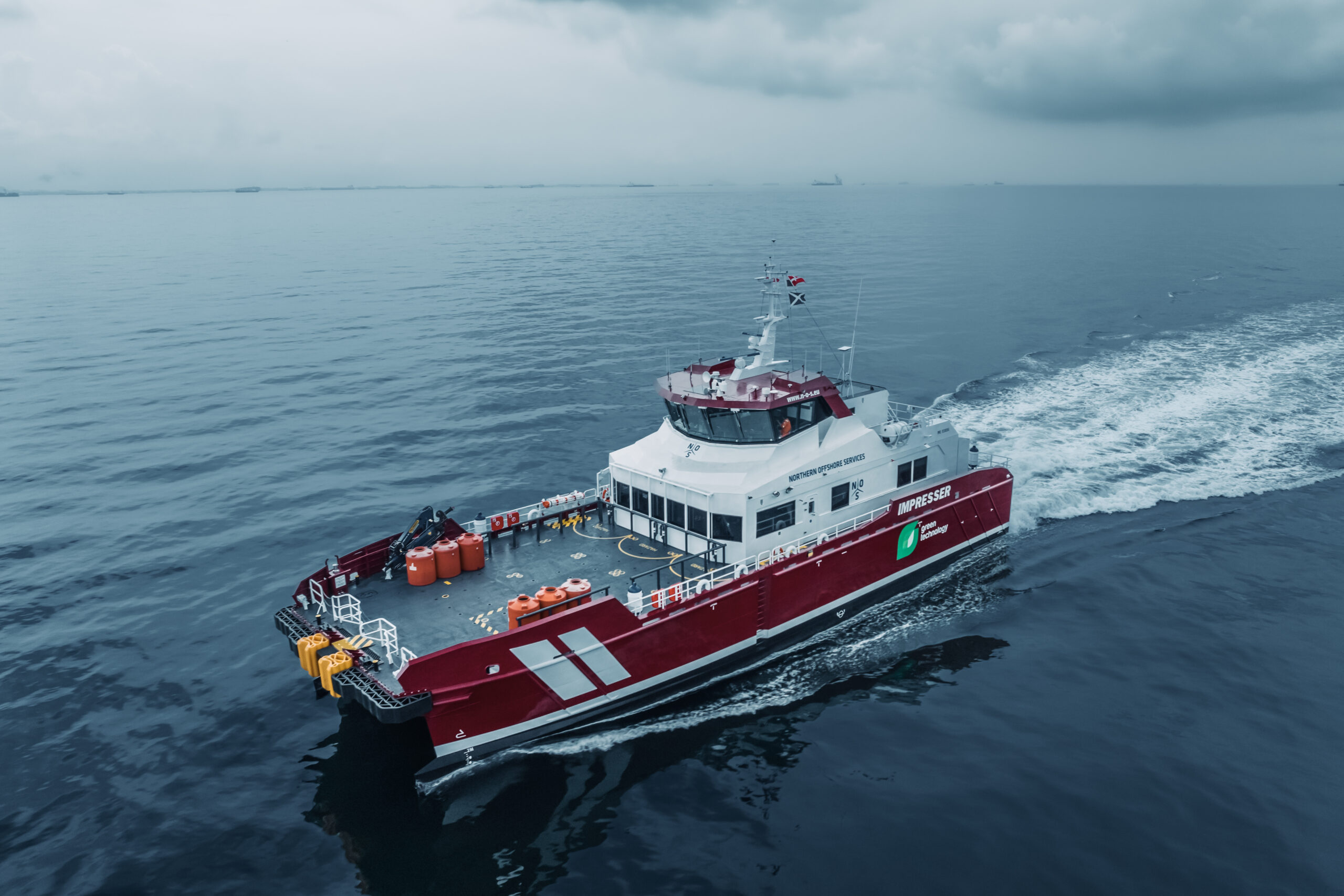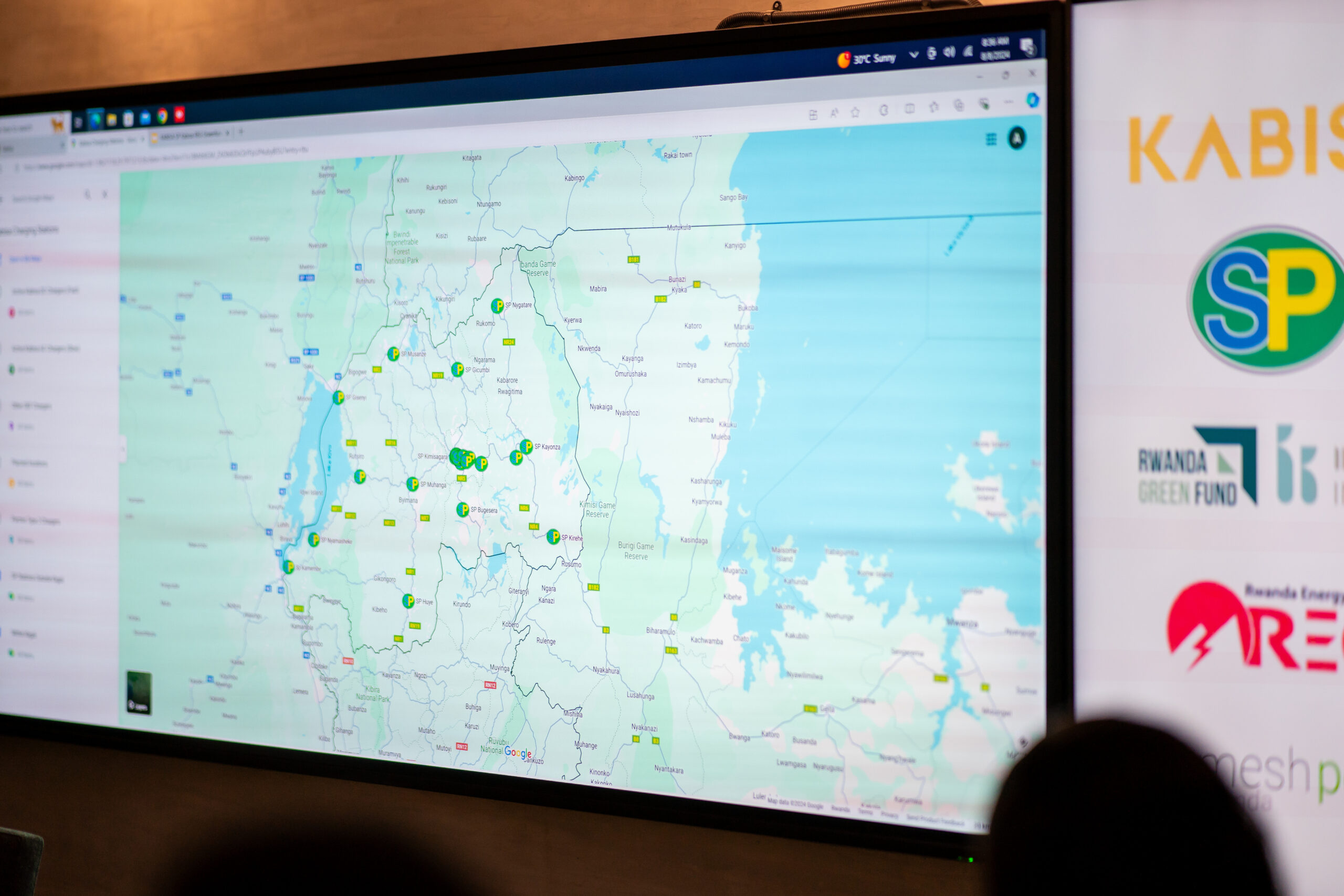Sign up for daily news updates from CleanTechnica on email. Or follow us on Google News!
Under the auspices of the India Smart Grid Forum, the think tank founded as an umbrella organization over India’s 28 state utilities to provide thought leadership, share leading practices, and bring international insights to India, I’m delivering bi-weekly webinars framed by the Short List of Climate Actions That Will Work. With the glories of online recordings and AI transcription tools, it’s relatively easy to share both the transcript, and also the slides that I used, so I’m making a habit of it.
Most recently, I delivered a talk and held a Q&A session covering my take on the end game for electrical generation technologies, which will dominate, which will be a rounding error, and which won’t exist at all. For those who prefer talk-talk to read-read, here’s the recorded video of the presentation and discussion.
Thank you, Reji and the assembled ISGF team. Hello to everybody, wherever you are in the world, whatever time zone you’re in. So, originally, I had assembled this particular set of material for a global investment bank, one of the larger ones. They asked me to speak to a global set of institutional investors who were trying to figure out the signal from the noise about what types of generation would show up on grids and what percentages, so that they could start thinking strategically about their portfolios, what parts of their portfolio are at risk, what parts of their portfolio strategy and investment theses should they start leaning into, and it remains useful for this context.
So, without further ado, I’m going to start through this. I’ll go through a whole bunch of different technologies and talk about what they’re useful for, how big they’ll be in the end game, regardless of how big they are now and what that likely means.

Let’s start with the basics. Hydroelectric. We’ve been doing it for a long time. In the future, it’s going to be about 10% of all energy, and let’s start there.
Electricity is going to be the basis of all energy in the future. We won’t be burning stuff, we won’t be digging up fossil fuels. We’re probably not going to making a lot of biofuels, except for long haul aviation and long haul shipping. Everything else will just electrify.
Hydroelectric is going to remain a useful set of that grab bag, even though it’s challenged by changes in precipitation. Part of the reason why coal went up last year was because there was a drought in western China, where the Three Gorges Dam is, and so they had to burn more coal to accommodate for the reduction in hydro generation.
But, you know, if we think the Three Gorges dam is big, well, China’s building a dam three times the size in the mountains to the west of there. We’re still building a lot of hydroelectric now, capacity changes a lot.
These tables stay the same through the presentation.
It has capacity. It has a distance from demand centers, which becomes important as we think about where to put stuff. Generation type synchronous versus asynchronous. Synchronous enables us to keep the grid on a steady heartbeat at steady hertz. Asynchronous provides us more flexibility and a smoother ramp up and ramp down curve. Synchronous, we tend to want on high voltage alternating current. Asynchronous can be on HVAC or HVDC.
Then we have flexibility. Flexibility is a huge component these days of what we need on grids. We need firm and flexible. We don’t really need baseload. We need firm and flexible generation because wind and solar are intermittent. Hydro can do base load and peaking.
Then there’s co-benefits, such as the voltage and frequency regulation, which I mentioned, which tends to be on the high voltage, alternating current grid. But that’s replicable with electronics these days. We also get recreation, irrigation, we even get a fishing industry on some of the big hydro dams. But there are the constraints. Seasonality of it is one. It tends to be more robust as a form of generation in the springtime. In a lot of geographies, that balances well with wind being more robust in the fall time. That becomes important as we start thinking about balancing the curves across time.
Personally, I think a lot of hydroelectric generation is just going to end up as passive batteries. We’ll let nature fill it up for us, and we’ll draw it down as required, depending upon lulls and other stuff. So it’ll be less of something we use all the time, and more of something we use, like modern gas and coal plants for peaking generation.

Next we get to coal generation. No surprise, I project zero room for coal in the future of the generation grid.
It’s fairly inflexible. It needs to be gigawatt scale for thermal generation.
The interesting thing right now is that as I look across the world’s coal plants, I see significantly declining capacity factors. While they’re designed to run at 90% plus capacity factors as baseload generation for the most part, if we take China’s coal, while they have all these permitted plants, and they have 1.1 terawatt of power capacity of plants in operation, there are two things that are important to note. One is that the capacity factor of their coal plants is less than 50%. It is almost exactly the same capacity as the United State’s natural gas plants. In other words, they’re operating it as peak demand power, not baseload power, for their country.
The nuance there is that as more and more renewables get built, and obviously China is building enormous amounts of renewables, that is going to decline even further. There comes a point where the plants are not profitable. Data out of the finance industry of China indicates that while there are a lot of plants that have been permitted, financial institutions are very leery about actually financing them.
While coal plants in China are getting all the news for permits, they’re not getting money and they’re not getting built. While I said there was 1.1 terawatts of power capacity there, they’ve also shut down 775 gigawatts of power capacity. That is two thirds of what they have operating. They’ve either shut down operational plants, the older, worst ones, or they’ve removed the permits because they stopped making sense. They shelved them, they mothballed them, they fully decommissioned plants.
There are some advantages there and some disadvantages from a constraint. All thermal generation plants, the legacy ones, many of them are being challenged by the requirement for cooling water. The thermal design was required for the water to be a certain temperature, so that it would actually cool everything down appropriately. But now the water is a lot hotter, and they’re getting into challenges, and frequently the water is just not there, so they can’t cool at all. Climate change is impacting a lot of the legacy coal generation plants and making permitting of new ones obviously more problematic.

Next we get to natural gas in the future, 1%, which might surprise some people, but let’s put that in context. Natural gas, or methane at least, is a useful endgame strategic reserve of electricity for really weird lulls, like the ones that occur every ten to 50 years where there’s a long period without the sun shining or the wind blowing, and a need for something else as a strategic reserve.
But natural gas generation can also be biomethane generation. I project a future where strategic reserves of electricity will be provided by capturing the methane that’s baking off our dairy barns, our landfills, our other sources of anthropogenic methane and put into strategic reserves instead of natural gas. We’ll be capturing a climate problem and storing it to solve an energy challenge, instead of just letting it leak to the atmosphere and be a climate problem.
Natural gas generation, especially combined cycle, is pretty flexible and it can be pretty close to human beings. It has high nitrous oxide emissions, precursor to smog that causes asthma in children, so not great to have right beside growing families, but it doesn’t have to be. It’s not nearly as bad as coal from a health impact perspective. And it has significant flexibility. It is a synchronous generation, so you have to spool it up.
There aren’t any co benefits. You don’t get voltage and frequency control. Especially in the past three or four years globally, what we’ve seen is massive gas price fluctuations structurally. This started in 2019, when the debt laden US shale industry and fracking industry started hitting roadblocks. Their projections of length of service, of fracked and unconventional oil wells were off. They were running about, they were operating about a third the length that they’d projected in their prospectuses, and as a result, they were going bankrupt. What we have is a situation where gas price fluctuations started being baked in. Then there was the Saudi Arabian, Russian oil war that was attacking unconventional oil extraction in 2021. That was impacting American shale oil as well, which is where they got 70% of their natural gas. That was all structurally causing challenges historically with natural gas prices that had been stable for about 18 years. Then Russia invaded Ukraine and the world’s gas prices just spiked.
As we move forward, the actual cost of gas generation is going to continue to be structurally volatile. As we model out the cost of that energy, it’s actually more expensive than we thought.
Then, of course, there’s the problem that methane along its distribution channel leaks. While the United States claims to have done a great job at reducing their carbon dioxide, their fracking and shale oil industry has increased methane emissions so much, they’ve wiped out their greenhouse gas gains from carbon dioxide. Natural gas was considered a bridge fuel. Well, it turns out the bridge is to nowhere.

We also use natural gas in a lot of places where we need heat and power. Airports are a classic example. There are a lot of airports that have natural gas plants that provide electricity for the facilities, which are fairly electricity demanding, but also heat for the terminal.
How much of that is going to continue? My projection a natural gas cogeneration is going to disappear. There are multiple places where natural gas cogeneration is used. There are district heating systems, steam assisted gravity drainage in the oil sands, there are airports and several other use cases. That’s going to all go away, in part because heat pumps work much more efficiently for heating and cooling and we’re going to have renewables.
It doesn’t make sense to do cogeneration and create greenhouse gas emissions. Once again, the gas price fluctuations are changing the economics.
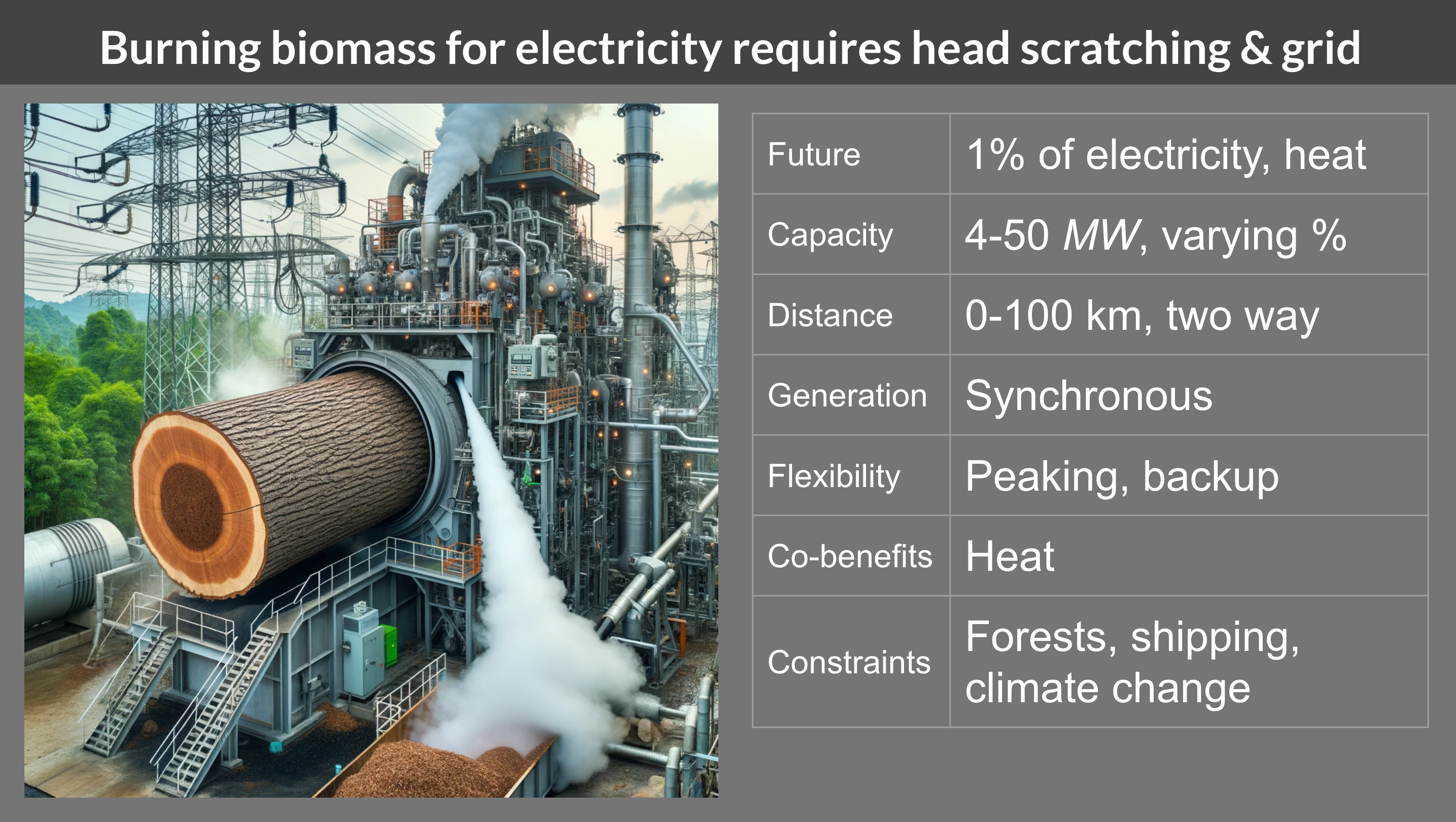
Another big chunk that’s used that a lot of people are considering is biomass. This is big in northern Europe for legacy historical reasons, cutting down old growth forests and burning them for heat or power is considered to be climate neutral, except they’re destroying a biomass sink. This is a really weird thing out of northern Europe, where they actually, in northern Germany and Denmark, what they’re doing is they’re having old forests in Finland and northern Sweden or in Canada or the United States cut down, pelletized into efficiently burning wood chunks, which means it’s not scrap wood, and then trucked or shipped across oceans, in many cases to be burned in Europe. And they are pretending that it’s climate neutral. I don’t buy it personally, and I think they’ll come to get a sense of reality on that.
But still, there’s a lot of scrap biomass out of the timber industry. We’re not going to turn all the scrap into biofuels, although that’s an entirely viable pathway. Some biomass for electricity will be on the grid somewhere. I think it’ll be smaller, it’ll be fairly small plants where there happens to be a big supply of timber or something like that, which is reasonably dry.
And the constraints there are obvious. It only makes sense when you’ve got a co benefit of heat and the constraints. We really shouldn’t be cutting down forests unless they’re going to be durable wood products. The fact that we’re cutting down the lungs of our planet to make chopsticks that we throw away once, or paper towels, it’s not a great idea. We’re going to start seeing more preservation of forests and less of a focus on biomass. It’s just not as sensible a pathway as many people believe it.
Now, there is an interesting edge case in agriculture, where biomass waste biomass is used for process heat, for food, for certain classes of food preparation, like for example, chili peppers. Most of those cases can be dealt with by heat pumps, but if they have a local supply of waste heat or waste biomass that would otherwise rots in middens and turns into methane because of anaerobic digestion, it’s reasonable to use it for process heat in that space, but you have be careful with that because the air pollution out of biomass is quite high.
I always like to say that the worst form of heating for human health is breathing the smoke from a dead tree. The amount of toxins that come out in wood smoke is remarkable.

India has a lot of nuclear, a lot of CANDU reactors. I looked at the fleet. Most of them are in the 300 megawatt range. So arguably, India was building small modular nuclear reactors before small modular nuclear reactors were a thing. Now, in recent years, India has realized the same thing that everybody else realized, which is that small reactors aren’t economic. It makes sense to get them up to the gigawatt scale. And so India has been building gigawatt scale reactors, and in the future, we’re going to have nuclear generation.
I just don’t think we’re going to have nearly as much of it as many people think. I think it’s going to be under 5% of the global energy supply, which is more than it is in terms of absolute numbers, but a lower percentage of electrical generation in relative numbers. And the reason for that is pretty simple. The graph on the left of the chart is a dataset I’ve been tracking of a natural experiment in China of nuclear generation deployments versus renewables deployments.
In 2014. Somebody said to me, well, obviously nuclear can scale and renewables can’t. I said, that doesn’t make any sense. We’ve got highly manufacturable items in wind and solar, wind turbines and solar panels that can have a massive global supply chain with low security risks and massively parallelized deployment. On the nuclear side, we have gigawatt scale megaprojects that can’t be manufactured and put in shipping containers and shipped to the other side of the world and turned on with semi skilled labor. It didn’t make sense to me that would be the case.
I looked around for a geography where the question could be answered by looking at what they’re doing. All the reasons that people in the West say that nuclear can’t grow mostly don’t apply to China. It should have been able possible to create all the conditions for success such as a long term stability of governance, which enables the nuclear programs to continue regardless of electoral changes in the west, for example, where nuclear is sometimes a part of the wedge politics. It has a national scale program for deployment as a national strategic requirement, has alignment with the development and maintenance of nuclear weapon capability, has the ability to do a national program for human resources, and it should have had the ability to pick a single design or two of technology to enable it to replicate its learning across all of its sites.
They could have had all the conditions of success. However, China is, much more than India, an export driven country. Its strategy is based on that. Instead they built one of every nuclear technology and design so they can export anything any customer anywhere in the world wants. As a result, their nuclear program is languishing badly.
I still think it wouldn’t have scaled nearly as quickly as renewables did. That white line is additional terawatt hours of actual generation with capacity factor added each year. As you can see, that’s still an accelerating curve. It’s going to accelerate for the next ten or 15 years as well. Meanwhile, nuclear peaked in 2016 and 2018 with about seven gigawatts of capacity, and it’s been adding much less capacity since then. Last year, it only added 1.2 gigawatts of new capacity.
The question for India, because I’m sure this debate is strong in the country is, if China can’t achieve the conditions for success for nuclear and renewables are so easy to build, which one should India be focusing on in the next few years? I certainly know which way I’m betting, and I’m not betting for nuclear.

Here’s where we get into the big wedges. Onshore wind farms, they need strong winds and they need a grid. About 30% of all energy for the world in my projection will come from onshore windfarms, and some of them are pretty honking big. We’re getting to the point now where I’m seeing quite large wind turbines on land. I think we’re peaking at about 5 MW capacity for an individual turbine. When we power old wind farms we’re getting a lot more power with a lot fewer wind turbines, getting higher capacity factors.
The generation is asynchronous. There was an experiment with synchronous wind turbines back in the seventies in the United States, which failed miserably. They ramp up and ramp down. As I said in the Electrify everything everywhere, all at once discussion and other previous discussions, one of the things that people don’t realize about wind energy is that it’s actually available about 85% of the time.
It only has a capacity factor of perhaps 40%, which means if we consider the wind blowing at perfect speed all year long, that’s 100%. The wind doesn’t blow at the perfect speed all year long, so the actual generation is 40% of the optimum generation. But the wind actually blows between the startup speed and the cutoff speed 85% of the year. Even on the edge days, we’re still getting a lot of electricity from wind.
One of the things that’s in the short list is overbuild wind and solar. And the reason for that is that 85% and the roughly half of a day, on average, that solar is doing something. As we add up those 50% of some generation from solar, and 85% from wind from when those curves start overlapping.
We have built more of every form of generation, except for nuclear, than we could possibly. Then we’ve underused them, like coal plants running at under 50%, and a lot of natural gas peaker plants running at under 10%.
We don’t have a problem with overbuilding generation and underutilizing it, and we’re not going to have that problem with wind or solar as well, especially because it’s cheaper than them. One of the nice things about wind and solar, they’re dirt cheap.
The co benefits are interesting. From a flexibility perspective, wind turbines are really easy to turn off, and they’re really easy to run below optimum and turn up. Simple SCADA commands from centralized grid management systems can easily manage wind assets to reduce their generation when we need a little less on the grid, but also to run them at 90% of their optimal, and then have 10% in reserve to pop them up as needed.
That co benefit comes with a reserve for voltage and frequency power management solutions that are on wind farms as well. Right now, we’re getting voltage and frequency support from big hunking, spinning chunks of metal in steam coal plant turbines and hydroelectric dams, and in nuclear plants, but we started requiring wind and solar farms to put on power management because they were so big that in order for them to be well managed participants in the grid, we needed them to replicate those ancillary services.
Increasingly, we’re going to be able to get the co benefits of voltage and frequency for the grid from wind farms, which are asynchronous but we’re using electronics to do that so they become much more flexible participants in the grid.
Remember, they’re running 85% of the time, just below maximum. We can run them at 90% of what the weather conditions might enable them which gives us immediate free backup that can be turned on electronically. This is just a market requirement.
The constraints are wind, and wind conditions do change over the year and over the day, and that varies a lot by geography. It’s not a slam dunk. It’s a great participant in the grid, but it is not the only participant in the grid.
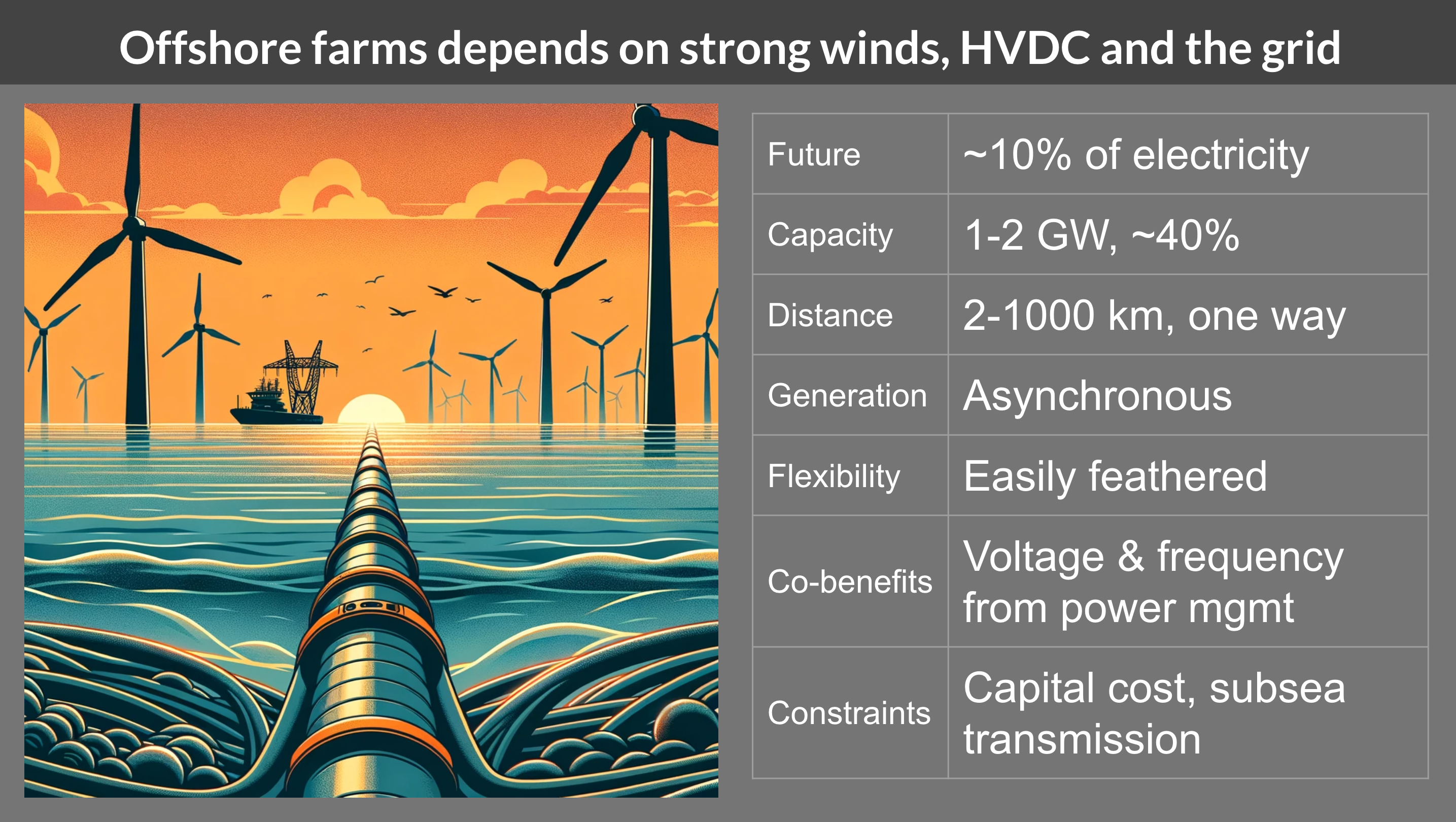
Offshore wind has some advantages that onshore wind doesn’t. The winds are a lot steadier, and they’re a lot firmer closer to the water, so the masts don’t have to be as tall. The logistics offshore means wind turbines can be massive. China’s putting in place, I think it’s a 20 or 21 GW single turbine this year. Turbines started out well under a megawatt. An over 20 megawatt single turbine is an astounding thing.
Logistics are easy because we can put them on ships. We don’t have to drive them along highways and get them under bridges and stuff like that. You can put them on ships where there’s many fewer logistical constraints.
Offshore wind has the same advantages as onshore wind, in that they are asynchronous and easily feathered.
One of the constraints is subsea transmission, but we’ve solved that problem. High voltage direct current interlinks are now regularly done everywhere in the world for offshore wind. The break even point is 50 km for high voltage direct current versus high voltage alternating current due to the characteristics of the power management solution.
One of the nice things about offshore winds is that frequently they can be put a lot closer to major demand centers. The United States has very specific constraints on its offshore wind because of the Jones Act that prevents maritime shipping from being sensibly managed for historical reasons. They’re really constrained in terms of putting offshore wind in there, and they’ve got billionaires with compounds who just don’t want to have a hint of a wind turbine on the horizon. We have a couple of headwinds there.
If they could put offshore wind off of New York state, they could be providing enormous amounts of electricity at times when it’s demanded for their biggest demand center of population. That’s why they keep trying despite the headwinds.
Offshore wind is going to be big. Its potential is understated. If we look at Japan, it actually has very significant offshore wind capabilities, it’s just not building them sensibly. It’s doing silly stuff. It’s talking about importing ammonia and co burning it with coal, which is going to be nine times the cost of energy. It will bankrupt their economy if they actually persist in going down that pathway.

Then, of course, solar farms, utility scale solar farms. My projection, 35%, the biggest single form of electrical generation. Ten years ago, I thought that wind might have the edge on solar. Now, I know that from the evidence of the past decade we put solar panels in containers, we ship them around the world, and they’re easy to install.
There’s this great video out of China of heavy lift drones plucking massive solar panels off a stack and flying them autonomously down to their location on a hillside solar farm. It’s astounding to watch. The scale of solar panels is right for human interaction. Containerization is a strong benefit.
Solar has all the advantages of wind. In New Delhi, where many of the participants are today, it’s about 12 hours of sunshine a day, which means 12 hours of solar generation, just not at peak. If there’s more solar farms, you get more electricity in the edge conditions, and it’s easily turned off. We can turn off strings of solar panels in a solar farm once again with the same SCADA commands that we use for wind turbines.
We can run solar farms suboptimally and turn on capacity if we’ve overbuilt solar or we can do things where we can actually load balance for putting heat into heat storage, and doing some industrial processes that require lots of electricity in the right time, when peak solar is done.
There is great flexibility with solar and wind that doesn’t exist with nuclear or coal which is underestimated as an advantage. Of course, if it’s cloudy, we get less electricity. If it’s nighttime, we get no electricity. So what? Everything has some constraints.
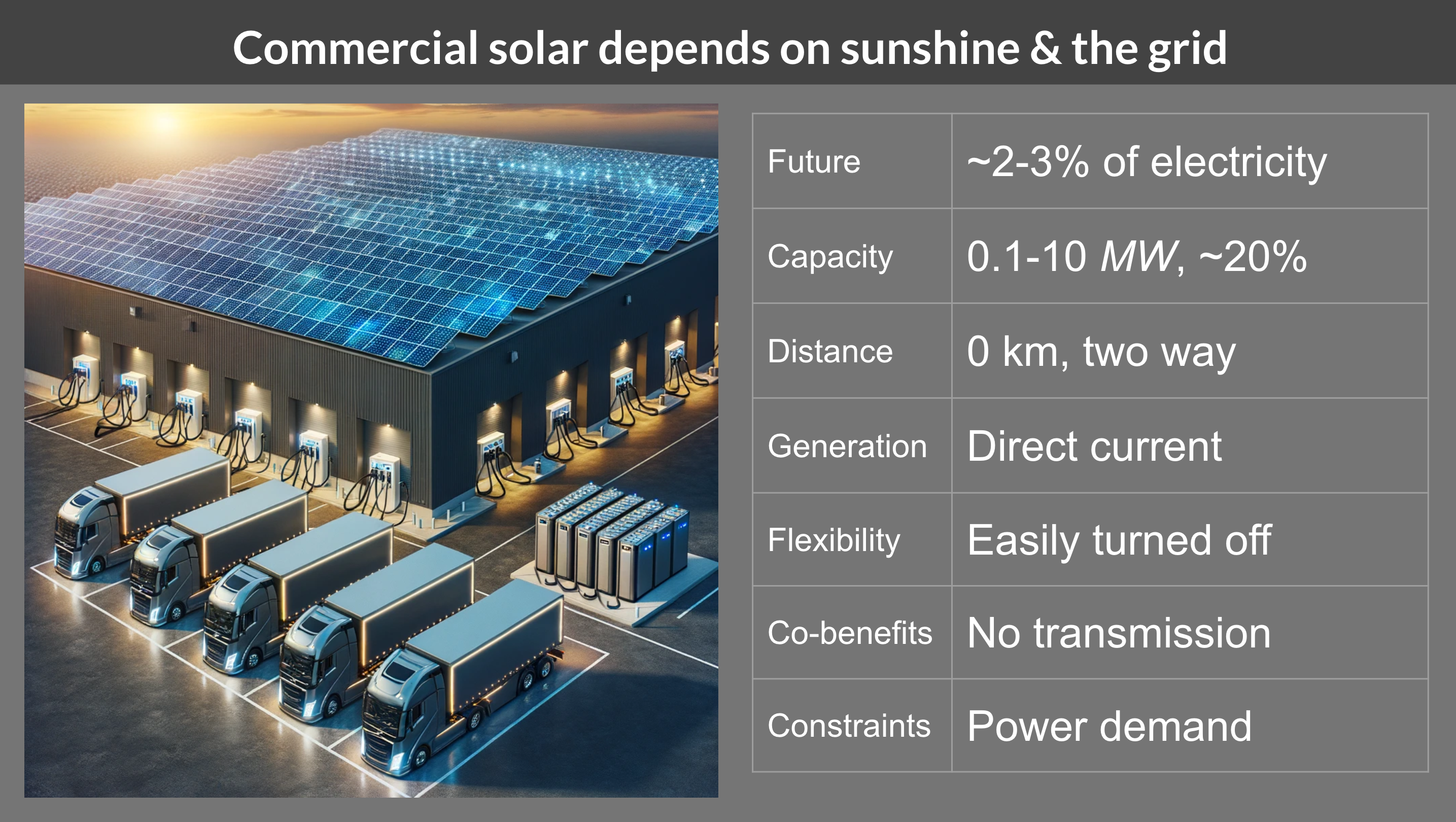
Commercial solar is going to be a big thing. Every country has big box warehouses. It has distribution centers for a modern distribution based economy. Those things have big flat roofs. Convention centers frequently have big, flat roofs. There are lots of commercial buildings where there’s lots of rooftops available for slapping on solar.
North America especially has big expanses around malls in where there should be solar canopies protecting the cars from sunlight and, oh, by the way, generating the electricity that goes into the cars. It’s going to be two to 3% of the global generation mix, in my estimation, because it puts electrical generation where there is significant demand. Distribution centers are increasingly going to have electric trucks rolling in and out.
They’re going to need big batteries. What’s going to feed the big batteries that buffer that stuff? Well, a lot of that is going to be rooftop solar. We don’t need nearly as much grid if we have ot more demand centers coated in solar panels.
That’s a big wedge and it’s an obvious one. I’ve dealt with a number of commercial solar developers who do very well for themselves because of this, and because of the the fall in solar panel prices these days, globally, it’s a no brainer.

Residential solar is a different story, 2% to 3%. I’ve had this debate with Mark Zed Johnson Jacobson out of Stanford. He and his team since the early 2000s, have been developing a model for 100% renewables by 2050. He’s one of the most influential people speaking about what the grid will look like in the future. And I disagree on some stuff, but mostly it’s matters of degree, not of kind. Mark thinks that rooftop solar between commercial and residential will be 15% of energy in the future. I think it’s going to be 5% to 8% between them for a simple reason. We’re not going to mandate that everybody has solar on their roofs. It doesn’t make a lot of sense to do that. There’s a lot of rooftops that are shaded. There’s a lot of rooftops that aren’t aligned well with the sun. There’s a lot of rooftops that people just don’t want solar on.
To be clear, Mark is a brilliant, great guy. I have a lot of time for him. We have spent a lot of time together. But he lives in the suburbs of affluent California, in a ranch home with a huge roof in a sunshine state. His perspective is bound by his conditions. I have spent a lot more time in Asia and in Latin America with my leadership roles in São Paulo and Singapore, and I traveled extensively around Asia and Latin America.
Most people don’t live in suburban ranch homes with massive roofs for a family of three or four. In Asia, 90% of people live in multi unit residential buildings, and those have much less ability to put solar on the rooftop to provide the power for the residents of the multi unit residential building.
I live more like an Asian person. I’m in a 19 story condo building with 233 units, probably 400 residents. That’s much more Asian than North American, so I tend to have a different perspective

I like to describe geothermal as a solution that’s really useful if you are in constant threat of having your country destroyed by earthquakes or volcanoes such as New Zealand or Iceland. I spent six weeks in New Zealand last year. I describe them as collections of volcanoes that are temporarily dormant. At some point, they’re just going to be wiped out by the equivalent of Krakatoa, but in the meantime, they’ve got great access to geothermal electricity.
The constraints of geothermal, I think, are going to leave it at about 1% of global energy generation. There are places like Japan, which should be leveraging their geothermal, and British Columbia, where I live, that should be leveraging geothermal where different preconditions means we aren’t. In Japan, the onsen culture means hot springs are sacrosanct in their culture, and you can’t touch them for a geothermal generation. In British Columbia, we have very few people. We have lots and lots of hydroelectricity, so we don’t really need to do geothermal.
We should be doing more of it. And so I don’t think it’s going to be a huge thing. I’m not that big on deep geothermal. There are construction risks there that I think are underappreciated.

Tidal electricity, there’s going to be some generation, but it’s going to be less than a thousandth of global energy needs. People don’t appreciate how hard it is to keep something operating underwater with moving parts offshore. Wind works great because there’s no moving parts underwater. Everything that’s underwater is just a wire, concrete or steel, and it’s coated steel, so it doesn’t corrode, it just accrues minerals and wildlife.
I’m including tidal here for completeness.
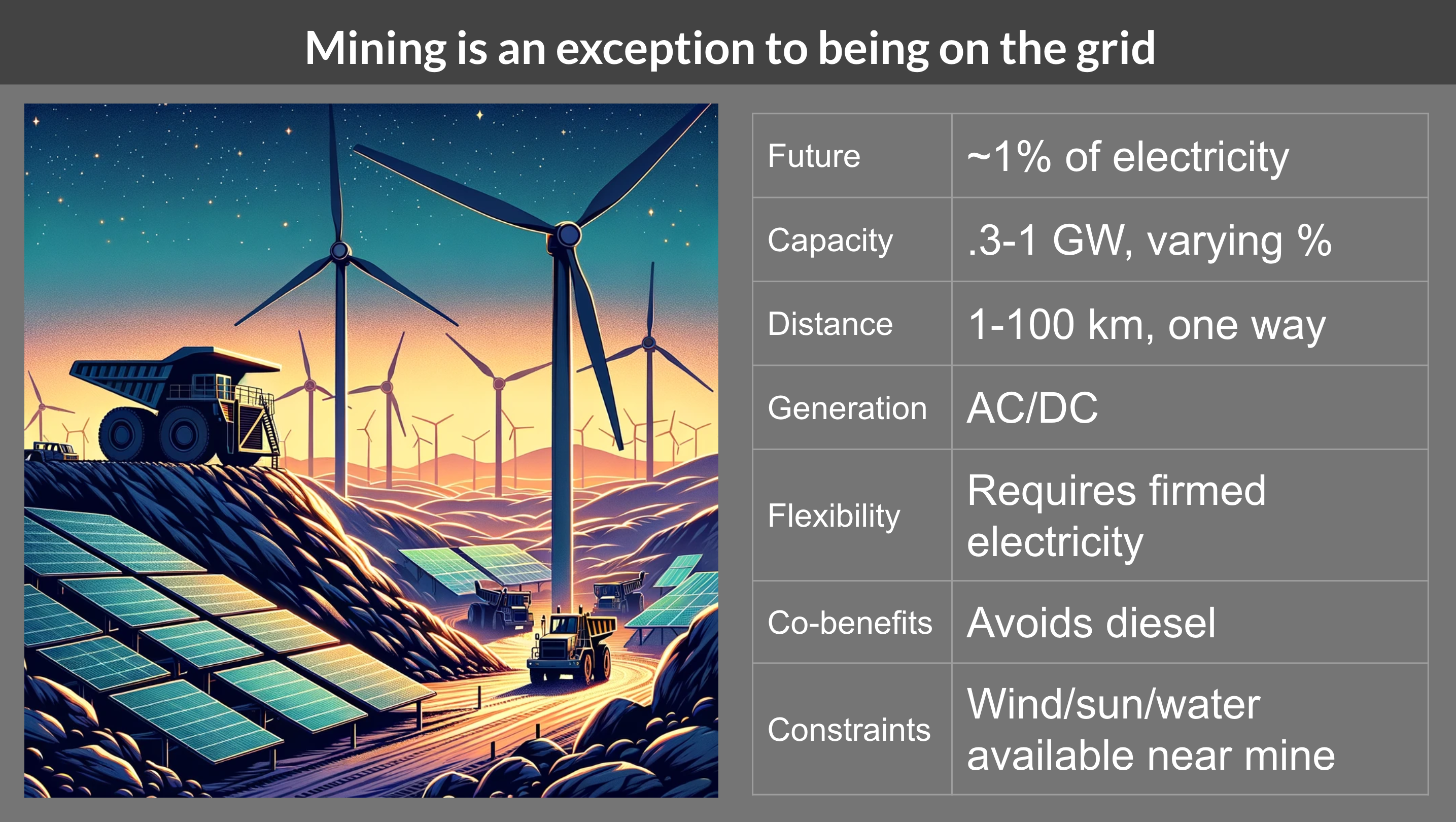
Virtually everything is going to be grid tied, so the grid can act as a battery, a demand center, and a supply center at least part of the time. A lot of generation that’s on the grid is there to supply the electricity that the grid needs. The rooftop solar and commercial solar that’s not on rooftops is still going to be almost entirely grid tied. It doesn’t make sense to not have it grid tied. You get a lot of benefits from the grid, like voltage and frequency control and backup that you don’t get if you’re not attached to the grid.
The grid remains an integral component of this. One of the challenges around generation is everybody seems to think that the wires don’t matter and that they don’t need to be paid for. That’s just not the case. Utilities have a purpose, and that purpose is to maintain the wires and the wires need to be paid for.
There’s a completely unreasonable conversation where people say, well, you have to get rid of the utilities. I just kind of scratch my head and think, have you ever actually looked at the way that electricity gets around?
Mining is an exception. A lot of mining is in remote areas where it doesn’t make sense to string a wire 1000 km. It makes sense to put up a six gigawatt solar farm for the duration of the mine and then rip the solar farm down and put it up next to the next mine, which is what’s happening in Australia. And in a lot of those places, they have lots of room for wind. I worked on an engagement briefly where they were putting three big wind turbines up in northern Quebec on a mining site in Raglan. It made a lot of sense. It avoids having to ship in a lot of diesel or other energy.
The mining giants have all agreed on this. Rio TinTo, Fortescue BHP and Vale have all said they’re going to electrify their mines, that it’s the pathway to the future. They’re going to build a lot of renewables close to the mines where it’s viable. They’re going to run transmission to the mines. It just makes sense. It’s the most efficient way to do it and it’s increasingly the most economically viable one.

The next one is grid storage. We just have lots of places we’re going to put grid storage and grid storage can be anywhere that it makes sense. One of the coming lectures in this seminar series is just all about storage and a discussion of India where there’s a lot more capacity for closed loop off river storage than the Indian outlook appears to believe, and I’m curious to explore that.
Battery storage has plummeted in price so much, they’re showing up on micro grids. They’re showing up in commercial facilities and distribution centers. They’re showing up in places where instead of strengthening the wires, the transmission or distribution, it makes sense to put a buffering battery at either end to optimize that physical asset of the wire. And so we’re seeing a lot of that stuff, and it increasingly can be thought of as a form of generation because it provides so many different pieces of capacity.
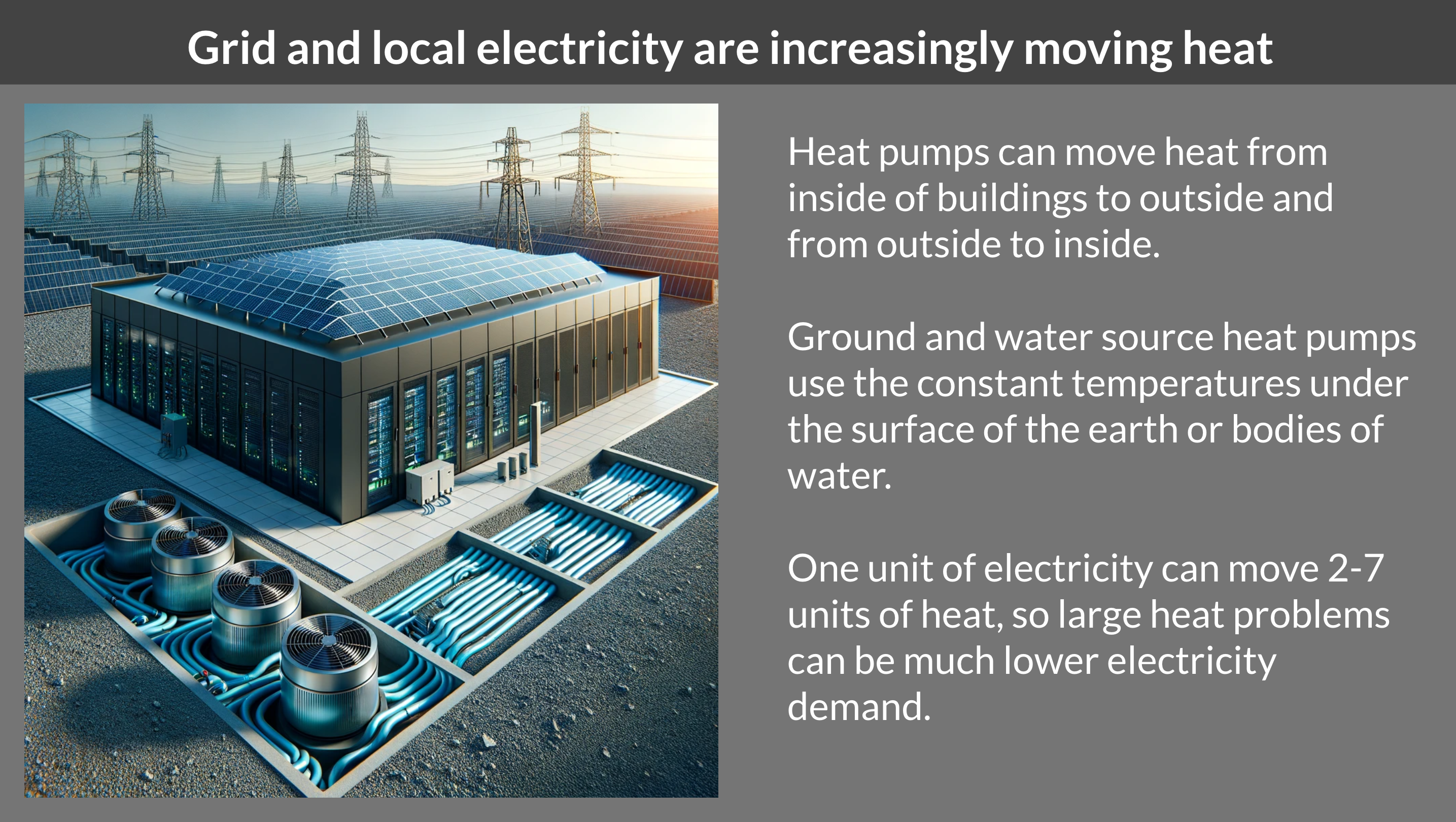
Heat pumps, whether ground source, air source or water source, are moving units of energy out of the environment into the places we need them. They’re using electricity to do that, but the efficiency is astounding. We end up with the ability to use a lot less energy for the same value proposition, so we don’t need to generate nearly as much electricity. There’s a lot of thermal storage that can balance energy within a 24 hours period. There are some significant advantages to thinking of environmental heat as an energy source in this context.
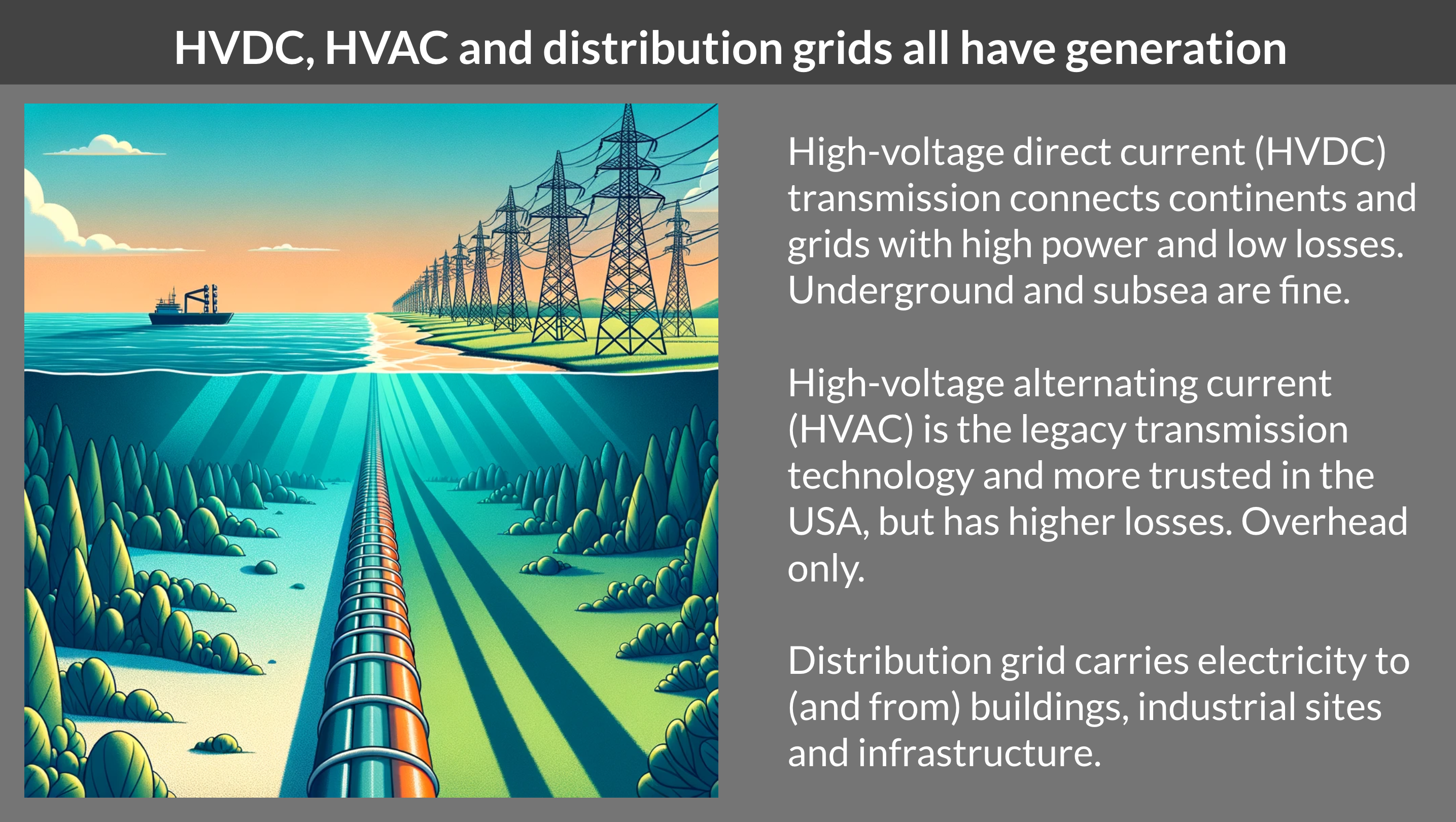
All of this generation is running on the grid, increasingly on high voltage direct current transmission. Now we have reconductoring as well. I’ll be talking about reconductoring and Heimdahl smart balls and high voltage direct current in another seminar in the series.
All grids are going to have a lot of different types of generation, and this isn’t a reliability issue. The grids in the world with the highest penetration of renewables, like Germany and Denmark, for example, are more reliable, with around 13 minutes of average outages per customer per year. Germany is an industrialized nation, it’s a high demand nation, and it gets 60% of its electricity from renewables.
German greenhouse gas emissions have cut by 10% over the past couple of years, and it’s accelerating decarbonization with cheaper electricity. Their wholesale electricity prices are among the lowest in Europe. They maintain artificially high electricity prices just as they maintain artificially high fossil fuel prices to incentivize efficiency. It works, but now they have to tweak that, make electricity cheaper and fossil fuel more expensive so they can get more people to electrify.

That’s the slides. Reji, I hand it over to you to moderate the Q&A.
Question
One is about he’s saying there is so much of investment done already on the coal plants, so why don’t we concentrate more on making the coal energy cleaner?
Answer
There have been a lot of attempts to try to pretend that coal can be clean. All coal can be is less filthy.
If we take the consideration of supercritical coal plants burning high grade washed coal and low sulfur coal, they can get down to the point where they’re only killing 40 or so people a year per plant. They can get down to the point where they’re only causing significant health degradation in a smaller portion of the population, as opposed to we’re seeing 7.5 to 12 million people a year having significantly degraded quality of life, productivity and lifespan.
Part of the reason that China is so focused on renewables and clean energy, and has shut down so many coal plants, is because they were seeing in northern China, twelve year reductions in lifespan. Their life expectancy was being degraded by coal generation.
And that’s why when I talk about China and coal, I say, well, they have replaced a lot of their brown coal plants that were running in just crappy ways. They’ve replaced them with supercritical plants, with low sulfur, washed coal that are running very efficiently. But still, that’s taking, from a climate perspective, 1,400 kilograms, 1.4 tons per megawatt hour of carbon dioxide from the worst coal plants, only down to about 800 tons from one of the new supercritical coal plants.
It’s not clean, not low carbon. It is not a pathway to the future.
The new supercritical plants are slightly more flexible, so they can be treated more as peak regeneration. And that’s probably necessary. But there’s no way to make coal clean or low carbon. It’s basically carbon rich dirt with mercury and other trace elements that end up in the environment and end up in our children, and end up in the biosphere, and end up in bioaccumulating plants and animals.
It’s really hard to actually bolt carbon capture onto an existing coal plant to deal with this. Boundary Dam in Saskatchewan attempted to bolt a carbon capture and sequestration solution onto their existing coal plant. After a few years of operation, they found a few things. One is, for many of the years, they’d only achieved 40% capture, well below the expectation. Second, they were using the carbon captured for enhanced oil recovery, pumping it down into tapped out oil wells to liquefy the sludge that’s left over, pressurize it, and enable it to be sucked out and then burned. Every time you pump a ton of carbon dioxide into an oil well for that purpose, you get about 0.2 to one tons of new petroleum, which when you burn it, negates the benefits of sequestering CO2.
Thing three is what they found is it made the electricity from Boundary Dam incredibly expensive. It was $140 per megawatt hour for coal generation, which is supposed to be cheap. What Saskatchewan did after that wxperiment was say, okay, we’ve tried it, it doesn’t work economically, and we’re not going to ever do it again.
The Petra Nova coal plant in the southern United States attempted something similar. They had twelve generation units in a massive coal facility. They bolted on carbon capture to one of them. They had to build a natural gas plant to power the carbon capture, because the auxiliary power drain of carbon capture compression and dealing with the carbon dioxide, which in the case of coal is over three times the mass of the coal.
It was a very big drain. The carbon capture and sequestration community claimed that was a success. They managed to get up to 93% capture for one month, but mostly, like Boundary Dam, it failed miserably to achieve its carbon capture objectives. It made the electricity incredibly expensive and they had to build a natural gas plant to provide the power with the right characteristics to run carbon capture. It doesn’t make any sense. It’s just a declining pathway to thermodynamic, economic and climate idiocy.
I don’t have any temperament that allows me to think that making coal cleaner is a solution. Using coal plants less is a solution if coal is required. Replacing your worst coal plants with a supercritical coal plant with low sulfur, washed, high grade coal is a solution, as you’d reduce the capacity factor of your coal plants.
The real answer is not to build more coal, if at all possible. And so for India, the question is, what’s that narrow pathway? If we think of the guide rails, how do you get as close to no coal? What’s the minimum coal that you can manage to build and manage to operate?
There are so many health impacts for your citizens, there are so many productivity impacts from the health impacts. You need a productive labor force, you need a healthy environment for your people to live in.
Coal does none of that. It kills people.
It generates electricity in the absence of anything else. Coal is better than nothing else. But we have alternatives now and they’re cheaper.
Addition by Reji
If you are done. Back to the questions. So India’s coal has high sulfur content, it’s not suitable for even carbon capture and storage even if the technology has matured. A desulfurization unit was approved by our central regulator and several people calculated different numbers. Just before COVID someone calculated that a plant which generates electricity at two or two and a half rupees, the desulfurization unit will add another 40 to 45. Nobody was willing to buy into that. It was a 20% to 25% increase in the price of power. Nothing has been done so far.
Now that battery storage has become much cheaper compared to many other technologies, the last two years the ISGF has been arguing that we should not spend that much billions of dollars installing desulfurization units on thermal power stations which we are going to retire after some years. Instead we should invest that money into building distributed storage on the grid by which we can integrate more solar and wind.
Question
35% of that global power mix will be solar. With so much uncertainty about the sunshine, how can we be so sure that 35% contribution of total power in future will be from solar power?
Answer
Two or three things related to this question. Yes, solar doesn’t work at night, and in heavy evening loads, there isn’t solar power. Well, time shifting solar a few hours is easy, using two different simple common technologies. India is, while not one of the biggest countries, it’s not Russia, it’s not China, it’s not the United States, it’s still the 7th biggest country in the world, and that includes east to west. So sunshine that’s hitting the west coast of India in a low demand period can be transmitted across India to high demand centers in the east. And similarly, you are in a geography where you actually have neighbors, and transmission can flow to your neighbors, so you can actually be transmitting peak solar across greater geographical distances. You’re already doing some of that. That’s going to expand.
The second thing is it’s easy to put a lot of solar energy into increasingly cheap batteries and shift the electricity a few hours into the evening. We’re seeing that increasingly occur in affluent countries and battery prices are plummeting. It’s even surprised me. Everybody’s being surprised by how much battery prices are going down. I’ve been saying that in 2020s, not betting on batteries is like around 2000, not betting on fiber optics and data availability, or wireless and data availability, it’s a similar kind of constraint. The constraint is a temporary one based upon an apparent lag. Right now, we’re seeing CATL projecting delivery of batteries at $56 per kilowatt hour of capacity. That’s a price point that wasn’t expected to be achieved until 2030 by people who are actually optimistic about batteries.
Then there’s the other forms of grid storage. I’ll be talking more about both grid storage and transmission in subsequent lectures. The sunshine hours availability, as I said in New Delhi, it’s 12 hours of generation. If we overbuild 25%, that actually accommodates most of our shoulder needs, and we can move the peak of sunshine a bit and actually then collaborate with wind and the other forms of generation that are on the grid to provide that power that we need. It’s not that hard.
Question
What is the optimal mix of sustainable energy capacity and technology deployment in a country like India.
Answer
There are people who’ve done this kind of work and there are lots of different scenarios. I encourage people to go to explore the Mark Z. Jacobson, which has a perspective on India. As said, he leans too heavily into rooftop solar from my perspective, but he’s in the ballpark. So you can look at his projections of transmission, wind, solar and water and get a pretty good answer there. It’s Mark Z. Jacobson, Stanford University 100% renewables by 2050. His models now extend to, I think it’s 145 countries globally because he reruns them with CIA factbook data for every country. It’s not perfect, but it’s a plausible scenario that’s worth looking at.
India has also has a future oriented grid strategy that it’s articulated. I disagree with aspects of it. It’s a bit too heavy on hydrogen, which is a dead end, and we’ll be discussing why. There’s a bit too much focus on nuclear and there’s too much of a reliance on fossil fuels. There’s an underappreciation of the value propositions of renewable energy, which is fairly typical for some of these legacy things.
Technology failed at this point, so the last couple of questions don’t appear in the transcript.
Have a tip for CleanTechnica? Want to advertise? Want to suggest a guest for our CleanTech Talk podcast? Contact us here.
Latest CleanTechnica.TV Video
CleanTechnica uses affiliate links. See our policy here.



